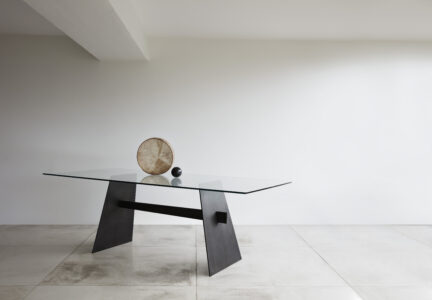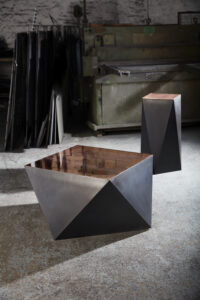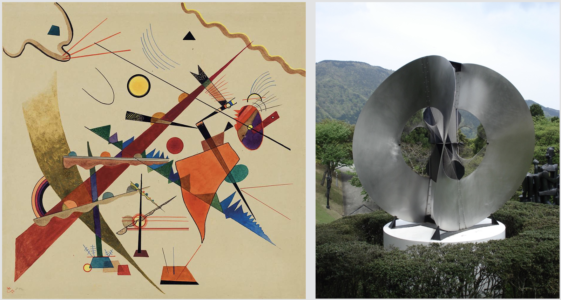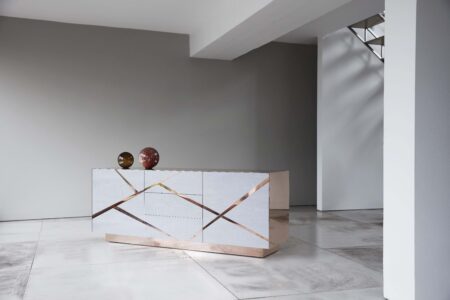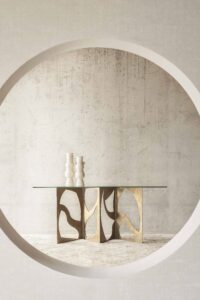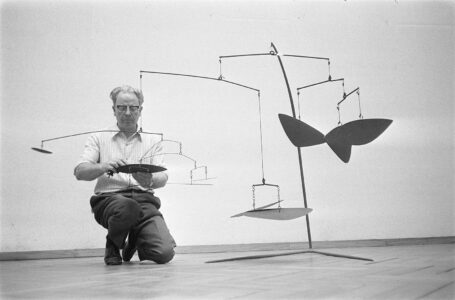There’s no shortage of inspiration to be found in the world. Some look for it in nature, others in travel, and many in art. Tom draws upon all these arenas to dream up new furniture designs, often combining the three along the way. Sculpture is one endless source of ideas which offers original ways of looking at material, form, and the underlying ideas which animate them. Over the years, Tom has been moved by the work of countless sculptors who help to reframe how we may look at the world around us. In celebration of these original modes of thought, he’s woven their elements into various designs, infusing a spirit of artistry and ingenuity along the way. Though fundamentally functional by nature, we feel furniture can and should offer more than simply a place to perch or rest a glass. Tom’s are designs which don’t need to be used to be experienced, and that’s largely due to the artistic throughline which permeates the collection. To offer some insight into the origins of his furniture designs, we’ve drawn together a few key sculptures which have offered inspiration. We hope they might, in turn, act as catalysts to creativity, if not intrigue…
Edge
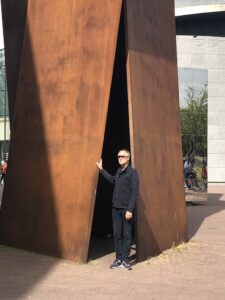
Tom with ‘House of Cards’ by Richard Serra (1969)
The Edge rectangular dining table has a sleek and elemental look to it which draws inspiration from the works of sculptor Richard Serra. Tom was inspired specifically by the artist’s ‘House of Cards’ sculpture, which draws sheer swathes of metal into delicate balance. Each piece relies on the next, leaning gently to support one another. There is a light touch to the work, despite the heft of its material. The effect is both starkly beautiful and intriguing from a structural perspective, as it appears frozen in a continuously tenuous state of balance.
Tom has recast these qualities into the Edge dining table. Its form is simple and unadorned, composed of just three sheets of metal. The two legs lean inwards and are met by a supportive central axis. The table is entirely self-supporting, as if existing in a loophole to the laws of gravity. We do weld the pieces together for the sake of peace of mind. Though, there’s a beauty in the minimalism of just a few simple and strong components communing in a delicate state of perfect balance.
Angel
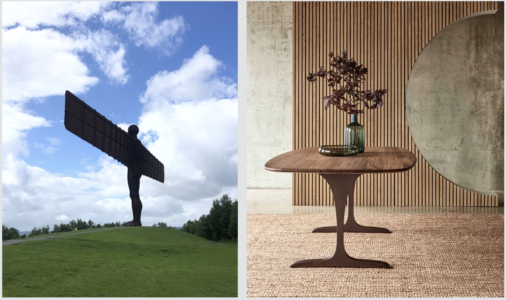
‘Angel of the North’ by Antony Gormley (1998); photographed by Tom (left) + Angel rectangular dining table finished in ‘Bronze’ with a walnut top (right)
As far as the inspiration behind our Angel dining table, the hint is in the name. Tom was struck by Antony Gormley’s ‘Angel of the North’, which presides over the north-eastern town of Gateshead. The monumental sculpture is made in Corten weathering steel, giving it an industrial flavour representative of its site on a former colliery. It’s a piece designed to dignify its hometown’s proud history of industry, with a highly engineered quality reflected in its carefully constructed exoskeleton. It stands watch over a region which, at the time of its unveiling in 1998, had a sense of being left in limbo between the industrial and information ages. It carries a defiant message: “we’re still here and we’re still standing strong”.
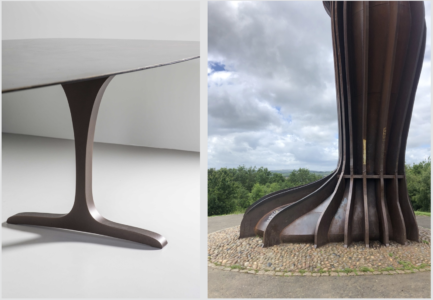
Details of the feet on the Angel dining table (left) + ‘Angel of the North’; photographed by Tom (right)
Tom was struck by the piece’s construction, and all the many details which allow it to endure amidst wild winds and biting rain. A strong foundation puts it in good stead, with curved feet which appear to cling to the land. Tom adapted this design element into the Angel dining table, grounding its metal form with elegantly tapered feet. The dining table has a certain lightness to it, with the feet splitting out from each pedestal leg into something of a plié. In the case of this sleek and streamlined design, the feet are the defining characteristic, imparting a sense of artistry into a functional object.
Balzac
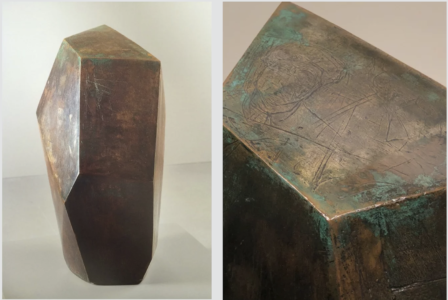
‘Cube’ by Alberto Giacometti (1934); photographed by Tom
The Balzac form is a weighty one made up of sheer, crisply defined faces. Its roots trace back to the work of Alberto Giacometti. He’s largely remembered for his spindly figures which lurch through space on slender metallic legs. Perhaps that’s why Tom was so struck by Giacometti’s cubic object – a marked departure from the artist’s usual visual vernacular. Though small in stature, it carries a sense of gravitas, declared in exacting geometry and beautifully patinated metallic surfaces.
Tom reproduced these qualities in the Balzac design, spinning them into a desk, coffee table, side tables, and even plinths. There’s a seriousness to these forms, which is tempered by an artistic bent. They appear more like sculptures than furniture, especially when embellished with plates of polished bronze or brass. The effect is clean and unadorned, relying on form to generate visual intrigue, every line carefully considered and executed with precision.
Odessa
The Odessa design was informed by the dynamism and linearity of Russian Constructivism. These qualities are most apparent in the paintings which sprung from the movement, with confidant slashes of pigment shooting across each canvas. The Odessa cabinet carries these same marks across its surface, with schisms in the wood revealing luminous veins of metal beneath. They carry a certain energy, with the piece appearing to fracture from a force within, creating a tug-of-war between covering and exposing.
The sculptural works of the Russian Constructivist movement speak to these same principles, with themes of linearity and dynamism expressed through form. Naum Gabo, for example, worked with metal to evoke this sense of spatial manipulation. His creations oscillate along axes to reveal how embodied material can manipulate, reveal, and define the energetic qualities of space. Though curved in their visible forms, the heart of each sculpture lies in the invisible lines from which they emanate. The exterior is dictated by the interior and its functional strictures, a creative approach which is echoed in the Odessa cabinet.
Eclipse
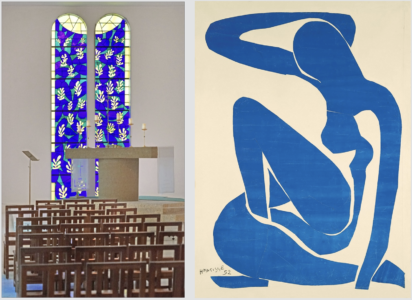
Stained-glass window (1951) in The Rosary Chapel at Saint Paul de Vence (left) + ‘Blue Nude’ (1952) (right) by Henri Matisse
The Eclipse console is a new design born from a spirit of ingenuity. Tom noticed a certain beauty in the sheets of steel left behind in the making of our Kintsugi Moon Cloud console table. The traditional Japanese kintsugi approach brings together separate pieces into a whole that’s stronger and more beautiful than the sum of its parts. We cut shapes of steel from a sheet and use ‘golden joinery’ the fuse them into one. Tom sensed potential in the remaining sheet of steel, with its geometric negative spaces. He was reminded of Henri Matisse’s cut-out series, as well as the stained-glass windows he designed for his chapel in Saint Paul de Vence, a place which Tom has visited a number of times. The resulting console carries a sustainable bent, repurposing what might have been discarded into something new and useful.
The Eclipse console is reminiscence not just of Matisse’s work but also that of Alexander Calder. The American artist was also active in the area, famously offering a large-scale mobile to La Colombe d’Or just down the road, which hangs over their pool to this day. The cut-out shapes which twist and turn in the breeze have a similarly abstract quality to them, relating to one another in exact balance. The Eclipse console, similarly, addresses this back-and-forth between negative and positive space, as well as how the two splinter off to create complementary objects.
Text by Annabel Colterjohn
